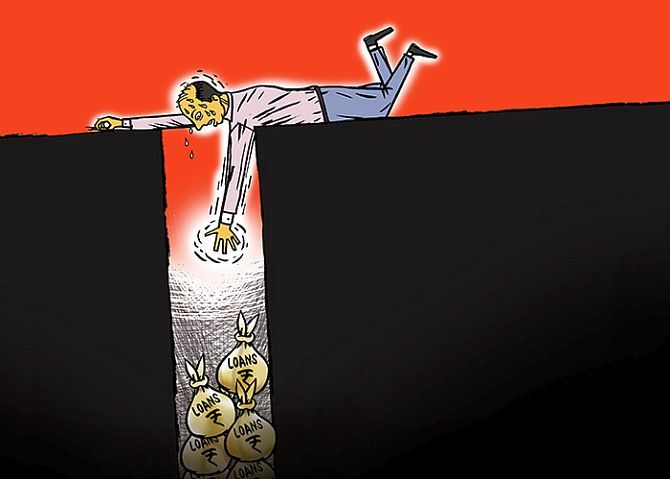While the five years of the Modi government have indeed seen a healthy increase in PSUs’ outlay and the Budgetary support for them, the next year’s numbers reveal the squeeze in the government’s own resources even though it is expecting a much higher dividend income from the PSUs.
These do not augur well for the PSUs in 2019-20 and the years ahead, unless these numbers are revisited and, hopefully, revised in the full Budget that will be presented later in July this year, says A K Bhattacharya.
Illustration: Dominic Xavier/Rediff.com

How has the Narendra Modi government managed the financial and investment needs of India’s public sector undertakings (PSUs)?
The Union Budgets for the last five years tell us an interesting story.
The popular narrative so far has been that the Modi government has squeezed public sector outlays and the total investments of PSUs grew at a tardy pace in this period.
But take a look at the five years of the Modi government, the story looks a little different.
Total capital outlay for PSUs in 2013-14, the last year of the Manmohan Singh government, was estimated at Rs 3.32 trillion.
This was about 21 per cent of the Union government’s total expenditure that year and a little less than 3 per cent of gross domestic product (GDP).
In 2018-19, the last year of the Modi government, the total capital outlay for PSUs has risen by over 163 per cent to Rs 8.74 trillion, accounting for about 36 per cent of the total government expenditure this year.
Even as a share of GDP, PSU outlay has gone up to 4.64 per cent.
The number of PSUs covered by these outlays has not declined significantly -- their numbers have gone down from 146 in 2013-14 to 139 in 2018-19.
A similar trend is noticeable for the total resources that have been made available for PSUs during these five years.
From Rs 2.58 trillion in 2013-14, these have increased to Rs 6.44 trillion in 2018-19.
Thus, PSU resources have gone up from being about a fifth of the Union government’s total Budget expenditure in 2013-14 to a little more than a third of the Union government’s total expenditure in 2018-19.
Their share in GDP has gone up from 2.29 per cent to 3.42 per cent in the same period.
The government’s Budgetary support to PSUs, also, has increased significantly in these five years.
It has gone up from Rs 0.69 trillion in 2013-14 to Rs 2.29 trillion in 2018-19.
Its share in the total Budget expenditure has doubled from 4.43 per cent to 9.34 per cent.
Similarly, the share of Budgetary support in GDP has risen from 0.62 per cent to 1.22 per cent in this period.
Budgetary support for the PSUs includes the government’s equity contribution and loans.
It is important to note that even by way of equity contribution, the government’s allocation for PSUs has gone up from Rs 0.64 trillion (4 per cent of total government spending) in 2013-14 to Rs 2.12 trillion (8.64 per cent of total government spending).
Even loans have risen at a similar pace from Rs 5,497 crore to Rs 17,100 crore in this period.
While the government has kept raising its allocations for PSUs through higher overall investment and Budgetary support, PSUs’ internal ability to raise their own resources have taken a hit.
This is a disturbing trend that could have adverse long-term implications for the PSUs.
Internal resources of PSUs, which are generated from their profits and retained earnings, have grown at a much slower pace, from Rs 1.72 trillion in 2013-14 to Rs 1.98 trillion in 2018-19.
Worse, as per cent of the government’s total expenditure, the internal resources generated by PSUs have fallen from 11 per cent to 8 per cent in this period.
Even as per cent of GDP, they have declined from 1.53 per cent in 2013-14 to 1.05 per cent.
A lower pace of increase in PSUs’ internal resource generation would suggest a decline in their overall financial performance.
However, the government has continued to secure for itself a decent increase in its dividend income from these PSUs in this period.
This is yet another disturbing trend as far as the prospects of PSUs’ long-term financial health are concerned.
Dividends income for the government from PSUs (excluding financial sector companies like the public-sector banks) has risen from Rs 25,921 crore in 2013-14 to Rs 45,124 crore in 2018-19.
A bigger cause for concern emanates from the interim Budget’s projections on the PSUs’ finances for 2019-20.
The total capital outlay for PSUs for the coming year will go down by 14 per cent to Rs 7.48 trillion, compared to Rs 8.74 trillion in 2018-19.
Similarly, the government’s Budgetary support for the PSUs would decline by a bigger margin of 43 per cent to Rs 1.3 trillion in 2019-20, compared to Rs 2.29 trillion in 2018-19.
Not surprisingly, the government’s equity contribution to PSUs will also drop by 47 per cent to Rs 1.13 trillion in 2019-20.
But the PSUs’ internal resources generation is expected to go up to Rs 2.2 trillion, an increase of 11 per cent over the amount in 2018-19.
And the government expects the PSUs to pay up a much higher dividend amount of Rs 53,160 crore in 2019-20, an increase of about 18 per cent over the previous year.
In sum, while the five years of the Modi government have indeed seen a healthy increase in PSUs’ outlay and the Budgetary support for them, the next year’s numbers for PSUs reveal the squeeze in the government’s own resources.
Thus, total capital outlay for the PSUs has seen a drop, for the first time in the last four years.
And even as the government has allocated less amount by way of equity support to the PSUs, it is expecting a much higher dividend income from them.
These do not augur well for the PSUs in 2019-20 and the years ahead, unless these numbers are revisited and, hopefully, revised in the full Budget that will be presented later in July this year.











